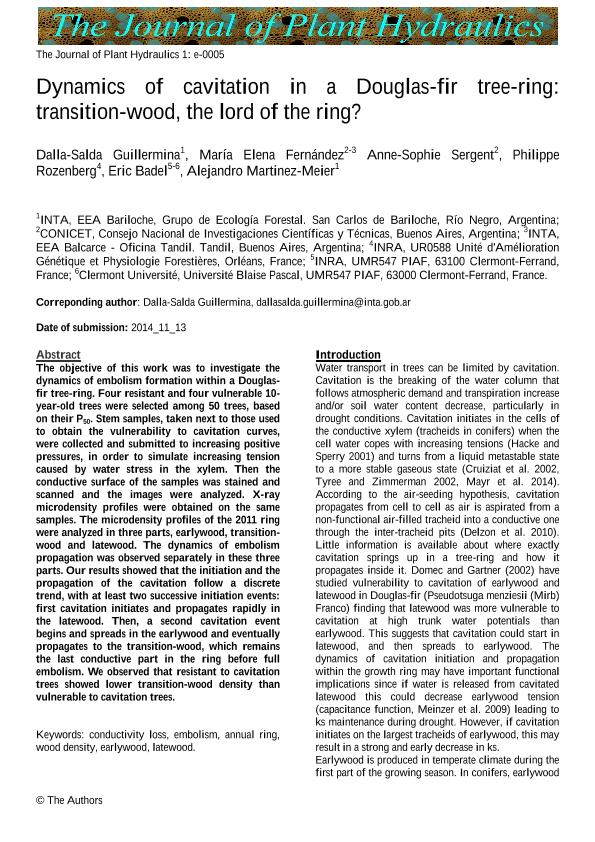Artículo
Dynamics of cavitation in a Douglas-fir tree-ring: Transition-wood, the lord of the ring?
Dalla Salda, Guillermina; Fernandez, Maria Elena ; Sergent, Anne Sophie
; Sergent, Anne Sophie ; Rozenberg, Philippe; Badel, Eric; Martinez Meier, Alejandro Gabriel
; Rozenberg, Philippe; Badel, Eric; Martinez Meier, Alejandro Gabriel
 ; Sergent, Anne Sophie
; Sergent, Anne Sophie ; Rozenberg, Philippe; Badel, Eric; Martinez Meier, Alejandro Gabriel
; Rozenberg, Philippe; Badel, Eric; Martinez Meier, Alejandro Gabriel
Fecha de publicación:
11/2014
Editorial:
Institut National de la Recherche Agronomique
Revista:
Journal of Plant Hydraulics
ISSN:
2268-4565
e-ISSN:
2426-413X
Idioma:
Inglés
Tipo de recurso:
Artículo publicado
Clasificación temática:
Resumen
The objective of this work was to investigate the dynamics of embolism formation within a Douglasfir tree-ring. Four resistant and four vulnerable 10- year-old trees were selected among 50 trees, based on their P50. Stem samples, taken next to those used to obtain the vulnerability to cavitation curves, were collected and submitted to increasing positive pressures, in order to simulate increasing tension caused by water stress in the xylem. Then the conductive surface of the samples was stained and scanned and the images were analyzed. X-ray microdensity profiles were obtained on the same samples. The microdensity profiles of the 2011 ring were analyzed in three parts, earlywood, transitionwood and latewood. The dynamics of embolism propagation was observed separately in these three parts. Our results showed that the initiation and the propagation of the cavitation follow a discrete trend, with at least two successive initiation events: first cavitation initiates and propagates rapidly in the latewood. Then, a second cavitation event begins and spreads in the earlywood and eventually propagates to the transition-wood, which remains the last conductive part in the ring before full embolism. We observed that resistant to cavitation trees showed lower transition-wood density than vulnerable to cavitation trees.
Palabras clave:
CONDUCTIVITY LOSS
,
EMBOLISM
,
ANNUAL RING
,
WOOD DENSITY
,
EARLYWOOD
,
LATEWOOD
Archivos asociados
Licencia
Identificadores
Colecciones
Articulos(CCT - PATAGONIA NORTE)
Articulos de CTRO.CIENTIFICO TECNOL.CONICET - PATAGONIA NORTE
Articulos de CTRO.CIENTIFICO TECNOL.CONICET - PATAGONIA NORTE
Citación
Dalla Salda, Guillermina; Fernandez, Maria Elena; Sergent, Anne Sophie; Rozenberg, Philippe; Badel, Eric; et al.; Dynamics of cavitation in a Douglas-fir tree-ring: Transition-wood, the lord of the ring?; Institut National de la Recherche Agronomique; Journal of Plant Hydraulics; 1; 11-2014; 1-5
Compartir
Altmétricas



